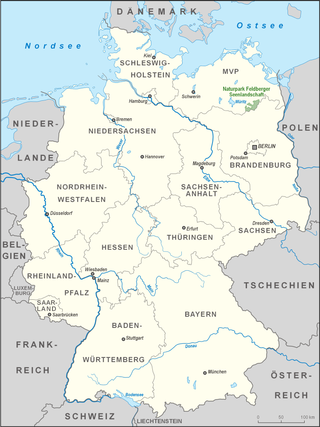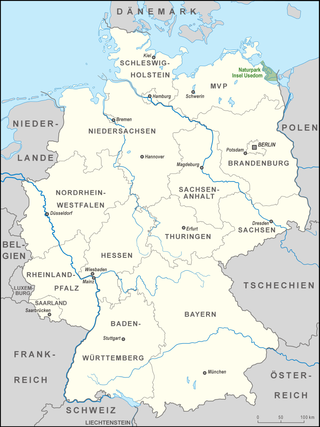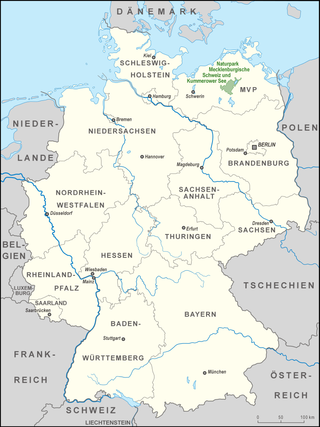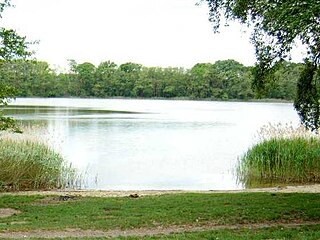Duchy of Lauenburg is the southernmost Kreis, or district, officially called District of Duchy of Lauenburg, of Schleswig-Holstein, Germany. It is bordered by the district of Stormarn, the city of Lübeck, the state of Mecklenburg-Vorpommern, the state of Lower Saxony, and the city state of Hamburg. The district of Herzogtum Lauenburg is named after the former Duchy of Saxe-Lauenburg.

Malchow is a municipality in the Mecklenburgische Seenplatte district, in Mecklenburg-Western Pomerania, Germany.

is a lake in Mecklenburg-Vorpommern, Germany, located at 53°27′57″N12°18′27″E. Its surface is approximately 38.4 km2 and its maximum depth is 25.5 metres (84 ft).

The Mecklenburg Lake Plateau or Mecklenburg Lakeland is the largest coherent lake and canal region in Germany and is sometimes called "the land of a thousand lakes". There are several nature parks and well-known lakes with unique flora and fauna in the region, such as the Müritz, the biggest German lake lying entirely within Germany, the Plauer See, the Fleesensee, the Tollensesee, the Schmaler Luzin and the Kölpinsee.

The Feldberg Lake District Nature Park lies in the southeast of the German state of Mecklenburg-Vorpommern in the district of Mecklenburgische Seenplatte. A large part of the nature park lies within the municipality of the same name, the Feldberger Seenlandschaft. In addition the municipalities of Wokuhl-Dabelow, Grünow, Carpin, Godendorf and parts of the towns of Woldegk and Neustrelitz fall within the nature park. The western end of the park is also a part of Müritz National Park.
Malchow is an Amt in the Mecklenburgische Seenplatte district, in Mecklenburg-Vorpommern, Germany. The seat of the Amt is in Malchow.

Malchow Abbey is a former Cistercian nunnery in Malchow in the district of Mecklenburgische Seenplatte in Mecklenburg-Vorpommern, Germany. The monastic buildings are on the east shore of the Malchower See and now accommodate the Mecklenburgisches Orgelmuseum.

Lüneburg Heath Nature Park is a nature park, a form of protected environment, located in the Lüneburg Heath in northern Germany.

The Lauenburg Lakes Nature Park was founded in 1961 and lies in the district of Lauenburg in the southeastern part of the German state of Schleswig-Holstein. It is right on the border with the state of Mecklenburg-Vorpommern in the Schleswig-Holstein Uplands, a Young Drift moraine landscape that formed during the Weichselian glaciation of the last ice age.

The Steinhuder Meer Nature Park, with northwest Germany's largest inland lake, the Steinhuder Meer, at its heart, covers an area of 310 square kilometres (120 sq mi) within the districts of Nienburg and Schaumburg and the region of Hanover. The sponsor of the nature park, founded in 1974, is Hanover Region.

The Usedom Island Nature Park comprises the German part of the island of Usedom in the district of Vorpommern-Greifswald in the state of Mecklenburg-Vorpommern, Germany. In addition to the island itself, the park covers the waterbody between the island and the mainland as well as small strips of mainland in the northwest and west near the seaside resorts of Lubmin and the town of Lassan.

The Aukrug Nature Park is a nature park in north Germany with an area of 380 square kilometres (150 sq mi). It lies in the centre of the state of Schleswig-Holstein in the region of Holstein. It is sponsored by an association formed by the 2 districts.

The Nowe Warpno Lake is a bay on the southern shore of the Szczecin Lagoon. It runs for about 6 kilometres (3.7 mi) into the interior and has two narrow channels to the lagoon in the north that are each only 150 metres (490 ft) wide and divided by a small island of reeds.
Mecklenburg Switzerland is a landscape in the middle of the German state of Mecklenburg-Vorpommern, north of the Mecklenburg Lake District and immediately northwest of Lake Malchin and Lake Kummerow. The region lies northwest of the line from Lake Malchin via the Dahmen Canal and Lake Kummerow to the Peene(canal) near Neukalen and from there southeast of the line from Lelkendorf via Lake Teterow, Teterow and Groß Wokern to the Malchin Basin. However, there is no precise definition of its boundaries. The majority of the landscape lies within the Mecklenburg Switzerland and Lake Kummerow Nature Park. Its attraction include its unspoilt nature, the hills, its villages that have preserved their original character and its castles. Some 19% of Mecklenburg Switzerland is woodland and 10% is water.

The Mecklenburg Switzerland and Lake Kummerow Nature Park lies in the northern part of the Mecklenburg Lake District in the districts of Mecklenburgische Seenplatte and Rostock in the German state of Mecklenburg-Vorpommern between the towns of Dargun, Demmin, Teterow, Malchin and Waren (Müritz). It was created in 1997. The total area of the nature park is 673 km2. 19 percent of this area is covered by woodland, ca. 10 percent by lakes and rivers, the rest is cultural landscape. There are 3 large lakes in the naturepark: Lake Malchin, Lake Kummerow and Lake Teterow. The Peene is the largest river in the park. The features that make it special are the large lakes, the riverine landscapes, the centuries-old oaks, the castles, the manor houses and their rural estates. The nature park is well known as a stopover for Nordic ducks. It is easily reached from the A 19, motorway junctions Krakow am See and Güstrow, or the A 20, junctions Tessin and Bad Sülze. The head office of the nature park administration is in Basedow.

53.56703°N 10.97654°E

The two giant sequoias near Kölpin in the parish of Demen in the district of Ludwigslust-Parchim in the German state of Mecklenburg-Vorpommern, are a natural monument. They belong to the species commonly known as giant sequoia, but also Wellingtonia and Sierra redwood.

The Sternberg Lake District Nature Park lies in the lake regions of Warin-Neukloster, the Sternberg Lake District and the central Warnow valley in the districts of Ludwigslust-Parchim and Nordwestmecklenburg in the German state of Mecklenburg-Vorpommern. It lies east of Lake Schwerin in the region of Sternberg, Brüel, Güstrow, Bützow, Warin and Neukloster.

The Rhine-Westerwald Nature Park is a nature park in Germany that covers an area of around 470 km2 to the east of the River Rhine and in the north of the state of Rhineland-Palatinate between Neuwied and Unkel. It extends from the Rhine over its eastern bank terraces up to the first hill ridge of the Lower Westerwald. The Rhine-Westerwald Nature Park is over 60 years old, making it one of the oldest in Germany. It was founded in 1962 and celebrated its 50th anniversary in 2012. Its legal owner is the society of Naturpark Rhein-Westerwald.
The village of Zarchlin is located in the Federal State of Mecklenburg-Western Pomerania in the north of Germany. It is part of the district of Ludwigslust-Parchim and belongs to the municipality of Barkhagen. About 100 people live in Zarchlin on an area of about 17.5 ha.




















